Precision pruning
With a view to reducing production costs, the mechanisation of vine pruning is tending to develop, especially in PGI and VSIG areas. Mechanical pruning machines, which are much more sophisticated than traditional pre-pruners, make it possible to carry out mechanised cordon pruning. Various technologies are available on the market, with cutting bars or circular saws, and some incorporate advanced systems such as automatic infra-red cord tracking. These innovations make pruning machines much easier to use and more efficient, while reducing the need for manual intervention.
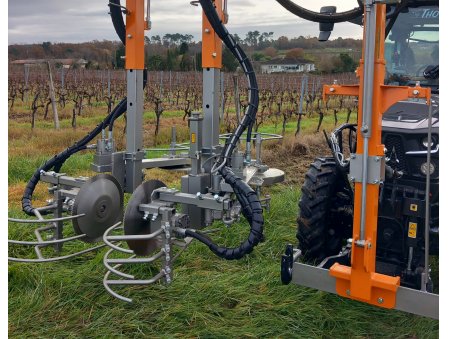
Work objective
With a view to reducing production costs, mechanised pruning is becoming increasingly popular. For a long time, this method of pruning was confined to vines destined for PGI or VSIG production, but it is now also used for PDO wines, whose specifications mention the possibility of cordon pruning. More than just improved pre-pruners, mechanical pruning machines are capable of pruning with one or two free eyes, following the cordon as closely as possible.Various machines are available with cutting bar or circular saw pruning systems.
Automated cord tracking (available depending on the brand) and stake detection greatly facilitate the use of mechanical pruning machines.
The cutting modules are fed hydraulically. The flow required to drive circular saws often justifies the use of a hydraulic power pack.
Components of the cutting machine
Cutting modules
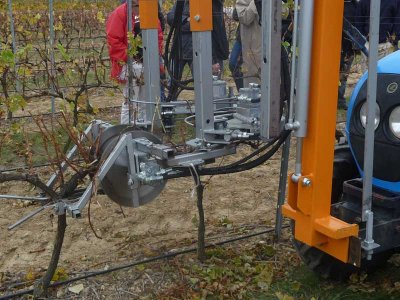
The aim of the cutting modules is to prune very close to the cordon, with 1 or 2 free buds, so as to keep manual labour (known as "repasse") to a strict minimum.
It is estimated that between 8 and 12 hours per hectare of vines need to be re-passed for PGI/VSIG vines.
Between 15 and 20 hours per hectare for PDO vines.
As a reminder, it takes 35 to 50 hours per hectare of pruning in a classic vineyard management scheme.
The vertical and horizontal cutting modules are either circular saws or reciprocating cutting bars.
The relative position of each cutting module is a differentiating factor between machines. The machine can also be integrated into the pre-cutting process.
It is estimated that between 8 and 12 hours per hectare of vines need to be re-passed for PGI/VSIG vines.
Between 15 and 20 hours per hectare for PDO vines.
As a reminder, it takes 35 to 50 hours per hectare of pruning in a classic vineyard management scheme.
The vertical and horizontal cutting modules are either circular saws or reciprocating cutting bars.
The relative position of each cutting module is a differentiating factor between machines. The machine can also be integrated into the pre-cutting process.

Video showing mechanical pruning in action!
Circular saws

- Consisting of two horizontal and two vertical saws (diameter between 360 and 500 mm)
- Clean and straightforward cutting of shoots, which cannot be resawed manually
- Requires high rotation speed (over 2500 rpm)
- The saws are sharpened every 2 days for the horizontal discs and once a week for the vertical discs
The cutter bar
- Clean cut
- Self-sharpening teeth (or change in sections if teeth are broken)
- Low projection
- Low noise level
- Low hydraulic flow demand (25 to 30 L/min)
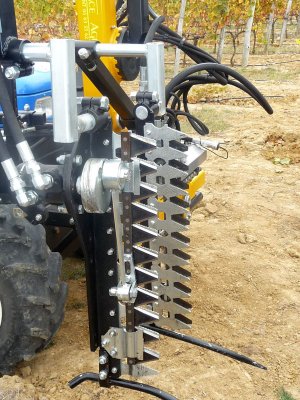
The engines
These cutting modules are driven by hydraulic motors to produce clean cuts at high rotation speeds (over 2,500 rpm).The positioning of the motors in relation to the circular saws (above or below) is part of the overall ergonomics of the machine.
The opening at the stake
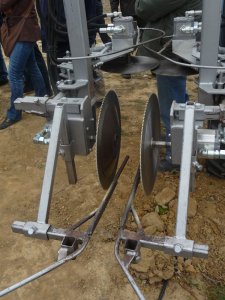
For pruners that can be used on free-standing or trellised vines, it is essential to have a device for opening the stakes when they pass through, both for the cutting module and the pre-pruning module.
This can be either a mechanical system using support and bypass, which is easy given the low forward speeds, or a hydraulically-assisted system using sensors.
Illustration of the guide rails in the foreground and the guides that allow the horizontal saws to move out of the way when passing a post in the background.
Cord tracking (manual or automatic)
Systems for following the cordon as closely as possible to the structure of the vine stock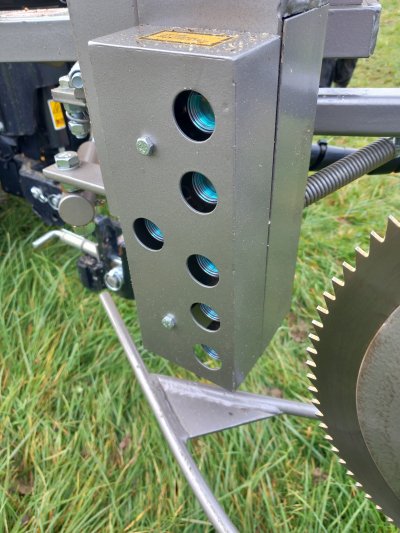
- Automatic cord height tracking using optical sensors (photo opposite). This option should not be overlooked, as it makes work much more comfortable.
- Manual cord tracking: not all brands offer optical sensors. In this case, cord tracking is done manually using the joystick in the tractor.
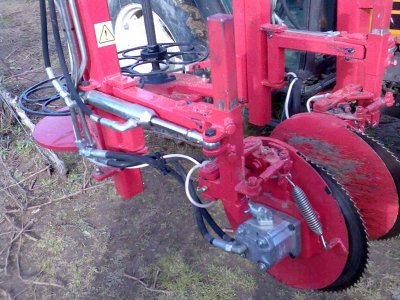
There are various ways of providing lateral support :
- Guide rails
- Gas springs
- Spring
- Double-acting probes and cylinders
Guide rails
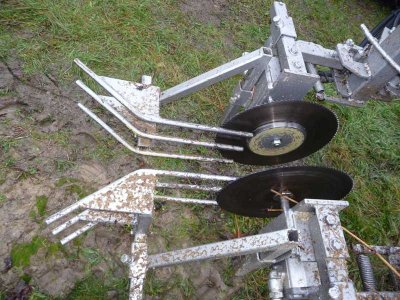
These long parts keep the machine in line with the row of vines, resting on either side of the vines.
 Machine fitted with alternative cutter bars (Chabas)
Machine fitted with alternative cutter bars (Chabas)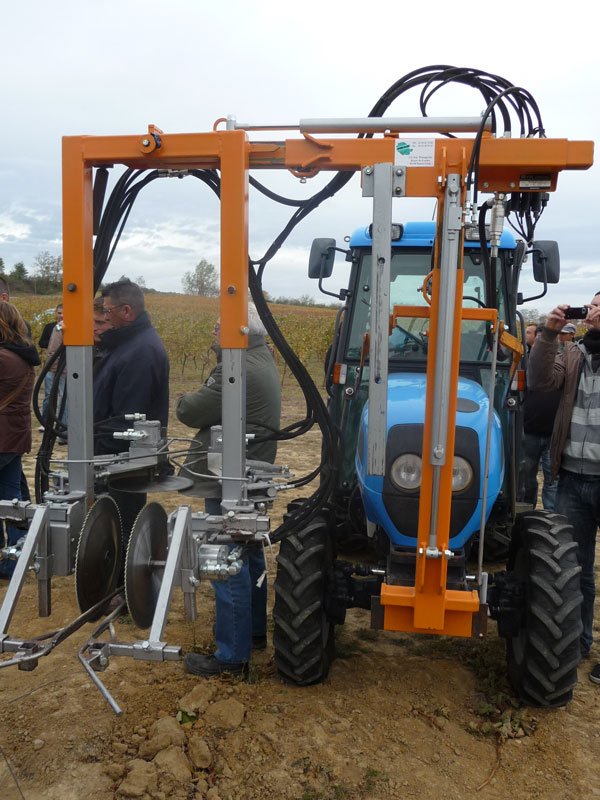 Machine equipped with circular saws (Terral)
Machine equipped with circular saws (Terral)Setting up and using the pruning machine
Mechanised pruning requires a great deal of concentration on the part of the driver, as the machine passes as close as possible to the cordon in order to carry out pruning with one or two free eyes. Whatever the method used to follow the cordon, the trellising must be kept as straight and rectilinear as possible in order to facilitate the passage, regularity and efficiency of the tool. In addition, mounting the machine on the front of an inter-row tractor will ensure better visibility for novice drivers.Thehydraulic equipment on the tool-holder mast enables the pruning module to be moved up and sideways. The post can be opened mechanically with assisted release (wheels, rollers, daisies) or automatically. Various systems are available for lateral tracking of the cord, such as guide rails or sensors and double-acting cylinders.
CAUTION: Mechanical pruning machines should not be used on plots where the trellising is of poor quality, as the machine is guided laterally by the row. Forward speed is low (around 2 km/h) and hydraulic requirements are fairly high, with oil flow rates generally in excess of 40 l/min.
The different ways of mounting short-cutting machines
- Can be mounted on a high-clearance forwarder and combined with a pre-pruner.
- Can be mounted on an inter-row tractor, with a multifunctional mast at the front (depending on the manufacturer).
A vineyard suited to mechanical pruning
To optimise this technique, it is best to establish the vineyard in a specific way so as to derive maximum benefit in terms of work organisation, lower costs and the long-term future of the vineyard.- You will find below all the prerequisites for mechanical pruning to be implemented in your vineyard, while complying with the specifications for PDO claims.
Mechanical pruning: an economic challenge first and foremost
Reduced labour costs
manual pruning accounts for a significant proportion of production costs (up to 30-40% depending on the farm).mechanisation reduces the need for skilled workers, which is particularly useful in a context of labour shortages.
Significant time savings
A mechanical pruning machine can handle several hectares a day, compared with just a few rows for a worker.This time saving means that critical periods such as winter pruning or pre-pruning can be better managed.
Mechanical pruning can also be used to passively combat frost in the vineyard.
Rapid amortisation of equipment
Although the initial investment is high, the return on investment is rapid thanks to labour savings and speed of execution. This type of equipment can be purchased by several winegrowers (CUMA) or contracted out.More regular and precise interventions
The precision of modern machines means that pruning is uniform and repeatable.There has been a significant reduction in wood diseases. This is because there is no cutting on the old wood.
In Bordeaux, thanks to mechanical pruning, 20-year-old Sauvignon Blanc and Sauvignon Gris vines have a mortality rate well below 10%.
Reduced physical stress for workers
Less intensive manual work, which can reduce accidents and sick leave.A look back at the demonstration of mechanical pruning equipment on 09 March 2023 in Mauriac
This pruning technique is fully in line with a low-cost technical itinerary. It cuts costs by simplifying or eliminating certain tasks, such as mechanised pruning, bending, pulling and crushing wood, and also reduces the incidence of wood diseases.Around 150 winegrowers turned out to see 6 machines in action on one of the vineyard plots that has been mechanically pruned for several years by the YON family.
6 manufacturers were present: ERO, TERRAL, CELLIER BOISSET, FERRAND, PELLENC and PROVITIS.
The tools ranged in price from €14,000 to €36,000, with the main difference in price being the 'automatic bead tracking' option.
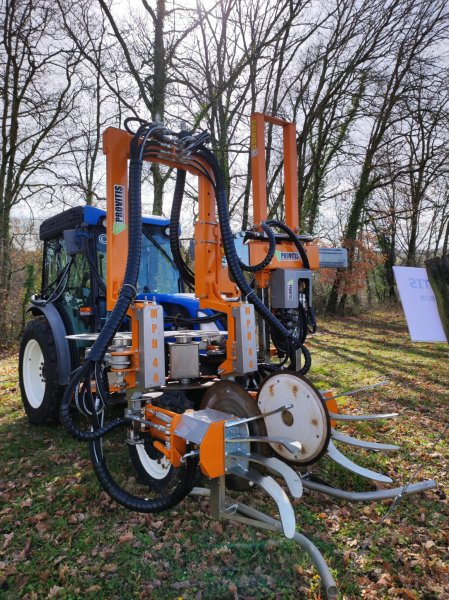
Provitis
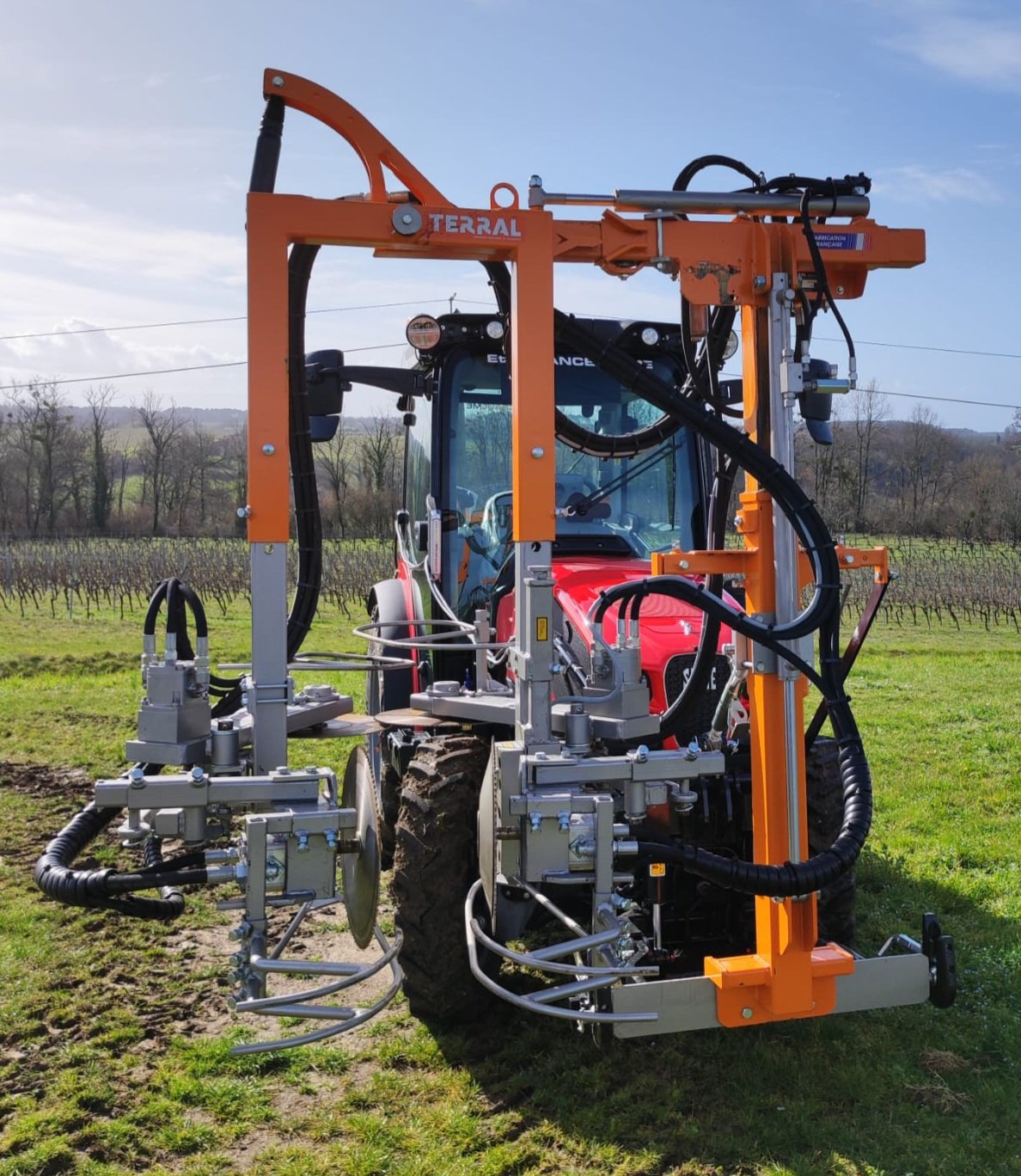
Terreal
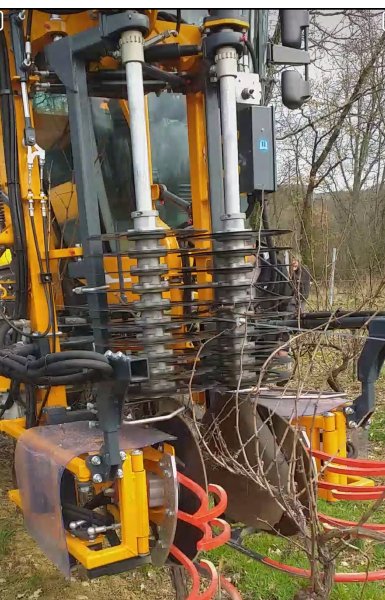
Pellenc
Experiment
See the list of experimentsSee more 











